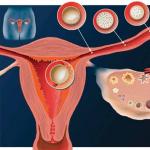Uterine cancer of the 2nd degree is a serious oncological disease, which at this stage is difficult to recognize due to the weak manifestation of symptoms. Therefore, many women are unaware of the presence of cancer. But in some cases, the pathology develops rapidly, causing health complications. Usually, oncological pathology develops against the background of chronic diseases of the genitourinary system already existing in a woman in the form of benign tumors and cysts.
Description of the problem: how many people live with cancer
Grade 2 uterine cancer is a pathology in which the neoplasm extends beyond the cervix, but did not have time to spread to the lower part of the vagina and the pelvic wall. A cancerous tumor at this stage of development increases in size, it becomes large, so it can be detected during a gynecological examination, although it does not show pronounced signs.
The oncological process in uterine carcinoma can be of the following varieties:
- Vaginal cancer, in which the tumor invades the upper part of the vagina.
- Parametric cancer, characterized by damage to the pelvic tissue on both sides.
- Damage to the body of the uterus.
The second stage of cervical cancer (CC) has two degrees of malignancy:
- Grade A is characterized by the location of the tumor in a certain place, when it does not extend beyond the structure. Metastasovrak does not spread.
- Grade B is caused by damage to the space around the uterus and connective tissue, which is located on the sides of the organ, as well as the absence of metastases.
Life expectancy at this stage of the disease in 75% of cases is more than five years.
Causes of Cancer Development
The causes of the development of cancerous neoplasms are not fully understood in oncology. There is an opinion that certain negative factors can provoke its development:
- HPV or human papillomavirus present in a woman's body;
- violations of the immune system;
- the presence of bad habits;
- frequent change of sexual partners;
- early or late pregnancy and childbirth;
- having an STD or HIV infection;
- numerous abortions;
- genetic predisposition;
- early sexual life;
- the use of hormonal drugs for a long period of time;
- diseases of the genitourinary system: erosion, warts, leukoplakia, benign tumors, lipoma, fibroma;
- diabetes and obesity;
- infertility and menstrual irregularities
Note! Obesity is one of the dangerous risk factors. The risk of developing cancer increases in those women who are overweight, while the prognosis of the disease in this case will be negative.
Symptoms of uterine cancer
Stage 2 cervical cancer may show the following symptoms:
- weakness and fatigue;
- loss of appetite and weight loss;
- dizziness, slight increase in body temperature;
- bleeding from the vagina, menstrual irregularities;
- feeling of pressure in the pelvic area;
- limb swelling.
Note! The main sign of the development of pathology can be spotting between periods, during menopause, weight loss and weakness.
The appearance of blood in the secretions is associated with damage to the growing tumor of the blood vessels and tissues located near the uterus. Cancer in the second stage provokes a violation of the reproductive function of a woman, metastases in this case do not develop in the lymph nodes and internal organs, for example, the lungs and pleura.
Diagnosis of cancer in oncology
Diagnosis of the disease is carried out using various methods. First, a woman is examined in the gynecology department, during which the doctor can detect a neoplasm. Then he sends for tests. One of the main studies in this pathology is the papillomavirus test by PCR. Also, a woman takes a blood test for tumor markers. A mandatory diagnostic method is a biopsy. It is not carried out only during pregnancy, bleeding disorders, infections of the genital organs and during menstruation. The study is scheduled seven days after the onset of menstruation, then the material taken is sent for histological examination.
Note! The results of a blood test for tumor markers are taken into account after studying the material taken during a biopsy, which makes it possible to speak with confidence about the oncological process in the cervix.
Additional diagnostic methods are colposcopy, ultrasound, curettage of the cervical canal, MRI, radiography and scintigraphy, CT.


Treatment Methods
Depending on the substage and the symptoms present, treatment may vary. At grade A, therapy will depend on the size of the neoplasm. Most often, doctors resort to radiation therapy in combination with brachytherapy - the introduction of a source of endowment into the vagina. This technique is used in the presence of a cancerous tumor larger than four centimeters. Along with this, the doctor prescribes a course of chemotherapy. After preliminary treatment, surgery may be used, although many oncologists state that surgery is not required at this stage. But often the uterus is removed with appendages and lymph nodes that are located nearby. The removed tissue is sent for examination, in case of detection of cancer cells, radiation and chemotherapy are prescribed. The survival rate of women in this case is high (75%).
In some cases, a woman after surgery may experience complications in the form of fistula formation, intestinal adhesions, bleeding, and pulmonary embolism.
With degree B, the operation is not performed, radiation and chemotherapy are used as treatment. It is not possible to remove the tumor due to its germination in the tissues that are located next to the uterus. Despite this, stage II uterine cancer has a good prognosis.
Note! After the end of treatment for stage II cancer, the doctor monitors the patient. If the pathology did not relapse, he performs the Wertgemer operation.
ethnoscience
Today it is not possible to cure uterine cancer with traditional medicine. But they are often used in combination with the main therapy to increase its effectiveness. Often, women use infusions of barberry and. For the preparation of barberry tincture, the leaves of the plant are taken and poured with alcohol in a ratio of 1:5. The mixture is sent to a dark place for one week. Ready infusion is consumed twenty-five drops before meals three times a day. Hemlock tincture is drunk in drops, as the plant contains poisons. Start treatment one drop three times a day, increasing the dosage every day until it reaches forty drops. After that, the amount of the drug is reduced in the same order. The food must be healthy.
Note! Hemlock is a poisonous plant, so use it with caution, constantly monitoring the state of health. In case of negative reactions, the drug is stopped.
Forecast and prevention
Since the disease in the second stage does not metastasize, the prognosis will be favorable. You can live more than five years after the treatment of pathology. But if a woman had uterine sarcoma, life expectancy is halved. In the case when treatment is not carried out, the cancer passes to the third, and then the fourth stage, which can lead to death. In the second stage B, women in 60% of cases live more than five years.
The second stage of cervical cancer means that the tumor has spread outside the organ, into the surrounding tissues. But it has not yet affected the muscles or ligaments that line the pelvis (the area between the thigh bones) or the lower part of the vagina.
To select the most effective treatment for stage 2 cervical cancer, this stage of the disease is divided into subtypes.
- Stage 2A - The cancer has spread to the upper part of the vagina. This stage, in turn, is divided into 2 A 1 (the tumor has spread to 4 cm or less) and 2 A 2 (the neoplasm is more than 4 cm).
- Stage 2B - The cancer has spread to the tissues around the cervix.
To select the right treatment, in addition to the stage, the type of cells in which the cancer began to develop, the presence of known mutations, the location of the tumor, and the general health of the patient are also determined. Life expectancy for stage 2 cervical cancer depends on all of these factors.
Treatment of cervical cancer stage 2A
The main methods at this stage of the disease are surgery and combined chemoradiotherapy. Surgery for stage 2A cervical cancer usually means that the patient's uterus and cervix will be removed (radical hysterectomy). The surgeon also removes lymph nodes around the cervix (pelvic lymph nodes). This is because there is a risk of cancer spreading to adjacent areas of the lymphatic system. In modern clinics, this procedure is performed in a minimally invasive way: using a laparoscope or a Da Vinci robotic system.
Combination chemoradiotherapy is the appointment of daily sessions of external radiation for 5 weeks, excluding weekends. Chemotherapy taken at the same time for stage 2 cervical cancer helps to increase the sensitivity of cancer cells to radiation therapy. At the end of the course, internal radiation therapy (brachytherapy) is often prescribed. Granules with a radioactive substance are injected into the cervical region and left near the site where the tumor was located. Depending on the radiation dose, the residence time of the pellets inside the patient's body also varies.
The prognosis for stage 2 cervical cancer, if the complex treatment is carried out correctly, is 63% of surviving patients within 5 years.
Treatment of cervical cancer stage 2B
If cancer has spread around the cervix, chemoradiotherapy is given without prior surgery. Doctors try to shrink the tumor with drugs and radiation so that they can then perform a more effective operation (remove all cancer cells). The prognosis for cervical cancer at stage 2B is about 50% of patients.
Targeted Therapy for Stage 2 Cervical Cancer
When specific mutations are found in the patient's cancer cells, modern clinics prescribe targeted therapy. These drugs target specific mechanisms in the tumor and therefore have fewer side effects than chemotherapy. For example, for the rapid growth of cancerous tissue, new blood vessels are needed. This process is called angiogenesis. Some targeted drugs (angiogenesis inhibitors) block the development of new blood vessels, thereby stopping tumor growth.
Insidious in its course and dangerous with severe complications and consequences, the disease in women is stage 2 cervical cancer. After all, up to half of the cases of a malignant process are asymptomatic. Therefore, the disease is diagnosed at a late stage, which significantly worsens the prognosis of a five-year survival rate.
Only a timely consultation with a gynecologist, as well as diagnostic and treatment procedures, helps to overcome cervical cancer and recover.
Symptoms and prognosis
At the second stage of a malignant lesion, clinical signs are minimally expressed, many women are not even aware of their illness. The severity of symptoms is different, but experts distinguish the most characteristic manifestations, according to which one can suspect the onset of an atypia focus:
- periodic discharge from the uterus - mucous, with bloody streaks or with impurities of pus;
- acyclic uterine bleeding - especially should be alarming in women in the premenopausal period of life;
- an unpleasant repulsive smell in the discharge - due to the decay of cancer cells occurring in the uterine cavity, the addition of inflammatory processes;
- the appearance of unpleasant sensations in the perineum, sacral spine - a pulling, aching character;
- increased pain impulses during sexual intercourse, physical activity.
How pronounced the clinical signs of cervical cancer will be depends on the area of the malignant focus, the involvement of neighboring organs and tissues in the process. Of the non-specific symptoms, the appearance of constant weakness, feeling of fatigue, persistent dizziness, loss of appetite and gradual loss of body weight are considered alarming.
However, the positive point in the question of how long they live with stage 2 cervical cancer is that the chances of recovery are quite high - up to 70-80%. The earlier a cancerous tumor is detected, the better the five-year survival prognosis.
Stages of cervical cancer and their prognosis
The focus of atypia in the tissues of the uterus can be triggered by various factors, but its localization at stage 2, as a rule, does not leave the uterus. However, variants of the course of the disease at this stage are possible. With the help of modern diagnostic procedures - ultrasound, colposcopy, hysteroscopy, specialists carefully examine a tissue site suspicious of stage 2 cervical cancer and make a full diagnosis.
So, it is customary to divide the course of the disease into three stages, on which it will depend on how long a woman has to live:
- With stage 2A cancer in the cervix, the prevalence of a malignant neoplasm occurs towards the vagina, however, it does not go beyond the cervix itself. This improves the prognosis of five-year survival with timely complex treatment procedures.
- At the 2B stage of the cancerous process in the cervical region, the tissues of the uterus itself, as well as the vagina, are involved in the process. Lymphostructures practically do not suffer, but single cells of atypia in them can be diagnosed. This situation requires an immediate decision on the treatment tactics. Otherwise, the prognosis worsens significantly.
- At stage 2B of neoplasm in the tissues of the cervix, the picture of the disease is much more serious - the cancerous process is detected in the entire thickness of the uterus, the walls of the vagina and tissues of the nearest organs, as well as the lymph nodes, are affected. The terms of five-year survival are much less, do not reach even 60%.

However, even at this stage of cervical cancer, a woman can live and be unaware of her illness, since she does not have any specific warning signs of the disease until very recently. Only a timely request for a consultation with a gynecologist and a full-fledged comprehensive examination puts everything in its place - at what stage the disease, its prevalence, whether the course of the disease is prognostically favorable.
Treatment tactics and prognosis
Not only the prognosis, but also the tactics of complex treatment, which will be chosen by a specialist, directly depends on the degree of progress of the cancer focus in the cervix. So, at stage 2A, preference is given to surgical excision of the tumor focus. Additionally, courses of radiation therapy can be carried out. In most cases, it is possible to achieve a long-term remission of the disease, with a high five-year survival rate.
Whereas the life of a woman with stage 2 B-C cancer of the cervix can be saved exclusively by the complete removal of not only the uterus itself, but also the adjacent tissues of the vagina, as well as lymph structures. In complex treatment, chemotherapy drugs and radiation exposure to the focus are necessarily present.
In many ways, the prognosis of a woman's future life after a diagnosis of stage 2 cancer in the cervix will depend on the correctness, as well as the speed of the decision made by the specialist regarding the tactics of therapeutic management of the patient. Both the age of the patient and the characteristics of her body - the tolerance of medical procedures, as well as the presence of concomitant somatic diseases - have an impact. 45-70% of cancer patients manage to survive the five-year milestone.
And even with a successfully experienced surgical intervention, there is a risk of recurrence of the malignant process in the cervix. To avoid such a complication, the implementation of the recommendations of the attending physician, the maintenance of a healthy lifestyle by a woman, including in the genital area, and the increase in immune barriers help.
Learning about your disease - cervical cancer stage 2 , do not despair. The achievements of medicine today are such that almost every patient has a chance of recovery. The prognosis will also depend on the mood of the woman herself - carefully following all the recommendations of the gynecologist-oncologist, eating right and getting plenty of rest, she makes a contribution to her health. Whereas the refusal to carry out medical procedures, for example, for religious reasons, will lead to a natural outcome - the rapid progression of the disease and death.
26.02.2017
The danger of this disease lies in the fact that most often it is diagnosed already at advanced stages, because at the beginning of its development there are no symptoms. Usually, cancer of the cervix progresses against the background of precancerous conditions already present in the patient.
It is important to attach particular importance to the fight against such a pathological condition of the reproductive system. In order to avoid serious consequences, it is necessary to visit a gynecologist annually to detect the disease in the initial stages.
The human papillomavirus (HPV) is considered to be the causative agent of this disease. It is detected in 100% of cases of oncology of the reproductive organs. According to statistics, this disease occupies one of the leading positions among oncological pathologies of female organs. In the second stage of cancer with timely treatment, a positive prognosis is observed that does not affect the life expectancy of a woman.
Signs and symptoms
With malignant tumors of the cervix, there are no pronounced symptoms, the disease is detected at a gynecologist's appointment. But there are some signs:
- bleeding unrelated to the menstrual cycle;
- constant slightly elevated temperature;
- suspicious discharge that appears after sexual intercourse (brown or light pink);
- increased fatigue, lethargy, decreased performance.
With the appearance of the listed symptoms, you need to contact a specialist for a diagnostic examination.
Characteristics of stage 2 cervical cancer
This pathology in the second stage already shows characteristic symptoms. These include: white discharge with bloody patches that have an unpleasant odor, and heavy bleeding during menstruation.
The development of a malignant tumor leads to the appearance of blood during sexual intercourse and after lifting weights.
A characteristic symptom for this type of oncology in the second stage is swelling of the legs. The growth of the neoplasm, damage to the intestines and small pelvis leads to pain during urination and intestinal obstruction. Then there is a noticeable weakening of the whole organism and a sharp loss in weight.
In the second stage, the development of a malignant formation outside the cervix may occur. There are three distribution options:
- Vaginal. With this option, infiltration of the upper part of the vagina is implied.
- Parametric. There is a defeat of the parametrium, often on both sides. There is no metastasis to the pelvic wall.
- The transition of cancer to the body of the uterus. This option is considered the most severe in the development of pathology.
Diagnosis of cervical cancer stage 2
To diagnose such a disease, stage 2 cervical cancer, the following methods are used:
- Cytological study. Using a special spatula, cells are taken from the surface of the cervix. Thanks to their study under a microscope, a conclusion is made about their structure. In case of suspicious results, additional research methods are assigned.
- Colposcopy. Studies of the cervix at the second stage using a specific device - a colposcope, are especially important, because the neoplasm may not be noticeable during routine examinations.
- Biopsy. If suspicious areas are found, a biopsy and subsequent histological examination are performed.
- Curettage of the cervical canal. With the results of a cytological study that showed pre- or cancerous changes, in some cases, curettage is performed. This procedure is rarely prescribed, usually only cytology and colposcopy can be dispensed with.
- Ultrasound diagnostics. This method is the simplest and painless. Difficulties can arise only with fairly common processes, as well as with adhesions of the abdominal cavity. For the most effective diagnosis, a three-dimensional image is used, which allows you to view the neoplasm from all sides.
- Magnetic resonance imaging. MRI allows you to choose the necessary treatment tactics and assess the condition of nearby organs.
- Chest x-ray, skeletal scintigraphy, abdominal CT. These methods are used to detect distant metastases, their control and treatment.
Reasons for the development of the disease
The reasons for both the formation and the progressive development of this disease, in addition to the human papillomavirus, can be:
- multiple pregnancy;
- sexual life began early;
- malnutrition, with a lack of essential vitamins and minerals;
- long-term use of hormonal drugs;
- venereal diseases;
- genetic predisposition;
The presence of these factors in a woman does not mean the presence of an oncological disease, but it is recommended to conduct a diagnosis.
The choice of treatment may depend on the prerequisites for a disease such as stage 2 cervical cancer. How long they live with this disease is also associated with the causes of the disease.
Treatment of cervical cancer
This pathology at the second stage of development is treated by various methods. The tactics of managing patients directly depends on the size of the neoplasm.
In stage 2A, apply:
- Complex of external radiation treatment and brachytherapy. If the tumor diameter exceeds four centimeters, then chemotherapy is carried out along with radiotherapy.
- Hysterectomy - removal of the tumor completely with the reproductive organ. Quite often used after radiation therapy.
- Radical hysterectomy. This method is complemented by the removal of the pelvic lymph nodes.
In stage 2B, a combination of external and internal radiation therapy is used. Radiotherapy is prescribed in combination with chemotherapy.
So, the question "how many people live with cervical cancer in the second stage of development" does not have a clear answer. This is due to the fact that some patients are able to achieve a complete recovery and lead an almost normal life, while others do not live even a year. The prognosis depends on the correctness and speed of treatment, as well as on the distinctive features of the patient's body: her age and the presence of other diseases.
4922
Pathology is increasingly common not only in older women, but also in young girls and, worst of all, in nulliparous women. According to statistics, this disease is the most common in women after breast cancer.
Unfortunately, it is very difficult to determine the disease at an early stage of development, since the symptoms are not very pronounced, so patients are in no hurry to contact specialists, and the lost time that could be spent on treatment exacerbates the situation. The stages of the disease have their own symptoms and prognosis. The lower the level of damage, the greater the chance of recovery.
Cervical cancer stage 2 life expectancy
The very first question that patients ask after diagnosing stage 2 is how long do they live after the diagnosis?
The chances of a full recovery are quite high, but it is worth considering several factors:
- The physical condition of the patient. Concomitant, chronic diseases can negatively affect health, and even treatment, these factors are always taken into account by specialists when determining the prognosis.
- Age. The younger the body, the more likely it is to actively fight the disease.
- Treatment. Only correct and adequate treatment received in a specialized medical center will give a great chance for recovery. Self-medication or refusal of medical care makes the chances zero.
- Lifestyle. Moderate physical activity, proper nutrition, clean environment, a minimum of stress will only benefit.
- attitude towards the disease. The diagnosis made by an oncologist is very scary, but the main thing is to find the strength to fight the disease and get support from relatives and friends.
If we compare the first and second stages, then with the first, the chances of recovery are 90%. The second has indicators much lower than 50-60%. But in order to prevent any of the above cases, it is enough to visit the gynecological office 2 times a year.
The first thing that disease specialists do is consult about the general condition and the presence of symptoms felt and analyzed by the patient. Next is an inspection. If the signs and the previous examination by the gynecologist indicated a suspected cancerous tumor, then the subsequent diagnosis with the appropriate tests should be done at the oncology center.
Analyzes and procedures for determining the disease:
- Colposcopy. Inspection of the affected organ using a special apparatus - a colposcope.
- Smear. The analysis is taken directly from the surface of the affected organ, using a tool designed for this.
- DNA test to determine the presence of HPV.
- Blood from a vein to detect cancer cells.
- Biopsy. Taking a piece of the affected tissue.
- Tomography. "Scanning" of the body from different angles.

Laboratory studies of blood and cells will give a clear picture of the progression of the disease. Tomography will show the tumor in different projections, as well as its possible growth in other, neighboring organs.
Cervical cancer stage 2 treatment
Treatment of a malignant progressive neoplasm is mandatory. Cancer cells have the ability to grow rapidly and, if they are not localized and destroyed, in a short period of time they can affect all human organs. As a result, the patient will feel excruciating pain. To prevent this, to prevent the occurrence of pathology, be sure to undergo a gynecological examination every six months.
If the diagnosis revealed a positive result for the presence of the disease, it is imperative to undergo a course of treatment from the prescribed list of procedures and prescriptions from the attending physician. Appointments are individual for each special occasion. It is important to undergo complex treatment, which includes:
- Operation. Surgery is done to remove the tumor. Depending on the growth of the tumor, the patient may have part of the organ removed.
- Chemotherapy. It is carried out only in a hospital, under the supervision of specialists.
- Embolization. This method is used if it is necessary to prevent hemorrhages of the uterus.
- Photodynamic therapy. It consists in introducing a photosensitive substance into the very middle of the tumor and parallel laser exposure. The procedure leads to the death of malignant cells.
Any of the methods is selected individually for each patient, the specialist should always take it into account:
- Health status;
- Age;
- Existing diseases;
- The reaction of the body to drugs, etc.
Chemotherapy for cervical cancer stage 2
Detection of metastases and an increase in lymphatic tissue in the groin area are symptoms indicating the second and third stages of the pathology. Treatment for this diagnosis in most cases is surgical with the addition of chemotherapy.
The drugs that make up the liquid medicine have a detrimental effect on cancer cells. Patients undergo at least three courses of therapy with a break between injections of one month (maybe more in some cases), to suppress tumor growth and metastasis.
The interval between the administration of the drug in one month, makes it possible for the body to recover to further fight the disease. During the rehabilitation period, the doctor prescribes a special diet to replenish the number of leukocytes in the blood, and sometimes even medical preparations.
Chemotherapy leads to a number of consequences that you should be prepared for. The first is hair loss. The chemical composition of the drug can affect the hair follicles.
Radiation therapy may be prescribed along with droppers. The device, which conducts radiation invisible to the eyes, kills malignant cells at the site of their localization. The course of treatment for each is individual and can be lengthy. After therapy, the patient may feel discomfort in the joints.
If chemotherapy and radiation therapy are carried out in the presence of metastases, then brachytherapy for stage 2 cervical cancer is prescribed in their absence. This method is famous for its effectiveness and the ability to preserve the reproductive functions of a woman.
A malignant tumor affects the lower uterus and vagina due to the mutation of epithelial cells. If not treated, cancer cells grow into healthy tissues, enter the pelvic lymphatic system, and lead to dysfunction of nearby organs.
With stage 2b cervical cancer, there is a high degree of survival if the pathology is diagnosed in a timely manner and effective treatment is undertaken.

The symptoms of the first stage do not appear practically in any way on the patient's condition, but are already noticeable during a gynecological examination.
The second stage has characteristic manifestations. A woman notices incomprehensible and unusual white discharge with an unpleasant odor, which can also be supplemented with blood. Menstruation at the same time is quite abundant, painful, sometimes bleeding occurs.
During sexual intercourse, or after them, blood appears, this can also happen when lifting weights, small physical exertion.
Periodic or aching pain appears in the lower abdomen. It spreads to the back, sacrum, legs. There is a violation of menstruation, the opening of bleeding in the middle of the cycle.
Symptoms of cervical cancer of the second degree in the form of a growing tumor lead to disruption of the pelvic organs, there are problems with urination and constipation. The patient weakens, loses body weight and hemoglobin level.
Despite the many years of experience of specialists and scientists in the field of cancer control, the exact causes of the occurrence of malignant cells and their progression in each case have not been scientifically identified. Only possible reasons are given:
- genetic predisposition.
- Chronic diseases of the genital organ.
- Venereal diseases.
- Frequent abortions with surgical intervention.
- papillomavirus.
- Unfavorable ecological environment.
- Taking hormonal drugs and much more.
To be confident in your health, you must: lead a normal, healthy lifestyle; contact medical specialists in time; do not fall for provocations and advice from the Internet on the treatment of this disease with folk methods.


















